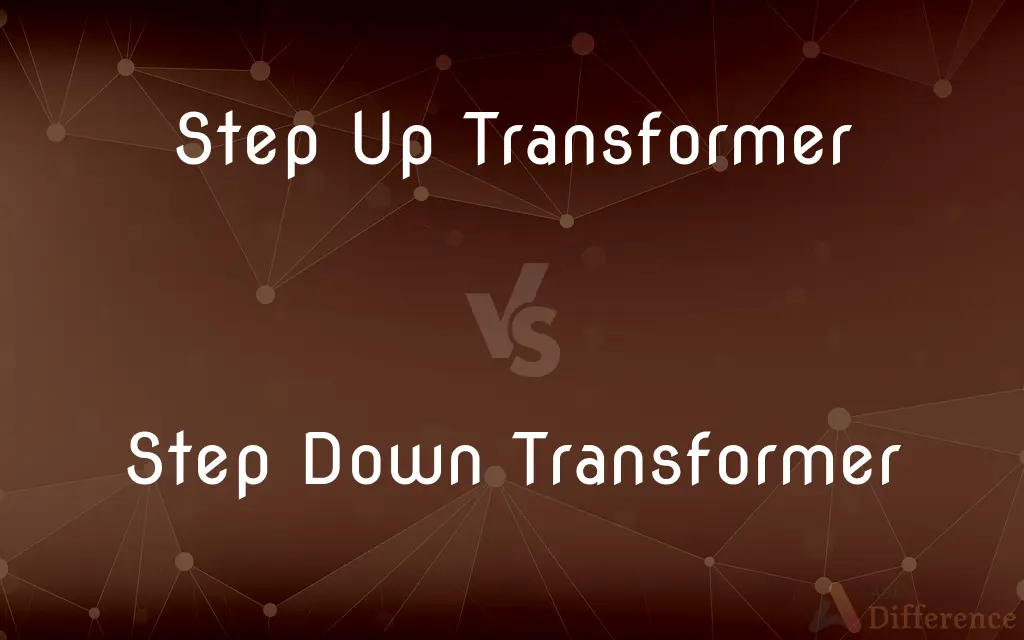Step Up Transformer vs. Step Down Transformer — What's the Difference?
By Fiza Rafique & Maham Liaqat — Published on March 1, 2024
A step-up transformer increases voltage from primary to secondary side, ideal for long-distance power transmission, while a step-down transformer decreases voltage, essential for safe household or industrial use.

Difference Between Step Up Transformer and Step Down Transformer
Table of Contents
ADVERTISEMENT
Key Differences
A step-up transformer is designed to increase the voltage from the primary coil to the secondary coil, making it crucial for efficiently transmitting electricity over long distances. This process minimizes energy loss by allowing the current to travel at a lower intensity. Conversely, a step-down transformer does the opposite by reducing the voltage from the primary to the secondary coil. This transformation is necessary for adapting high transmission voltages to safer levels suitable for residential and commercial applications.
In terms of construction, both transformers operate on the principle of electromagnetic induction but differ in the number of windings on their coils. A step-up transformer has more windings on the secondary coil than on the primary, whereas a step-down transformer has fewer windings on the secondary coil. This difference in winding counts directly influences the voltage transformation capability of each type.
The application of step-up transformers is predominantly in power generation plants and transmission lines, where boosting the voltage is essential for reducing energy loss over distances. Step-down transformers, on the other hand, are commonly found in distribution substations and various end-user points, where they lower the voltage for practical and safe use.
Efficiency is a critical aspect of both transformers, with the design tailored to maximize power transfer while minimizing losses. Although both aim for high efficiency, the specific requirements for voltage levels and current dictate their respective designs and materials used.
Safety features also vary between the two, as step-down transformers often incorporate more robust safety measures due to their proximity to end users. These transformers are designed to ensure the voltage is at a safe level before it reaches any electrical devices or outlets, thus preventing potential electrical hazards.
ADVERTISEMENT
Comparison Chart
Purpose
Increases voltage from primary to secondary side
Decreases voltage from primary to secondary side
Coil Windings
More windings on the secondary coil
Fewer windings on the secondary coil
Application
Power transmission over long distances
Household and industrial electrical use
Efficiency
Designed for minimal energy loss at high voltages
Optimized for safe power delivery at usable voltages
Safety Measures
Standard according to transmission requirements
Enhanced for close proximity to users
Compare with Definitions
Step Up Transformer
Increases electrical voltage.
A step-up transformer is used in power plants to raise the voltage for transmission.
Step Down Transformer
Decreases electrical voltage.
A step-down transformer is crucial for converting high transmission voltages to safe levels.
Step Up Transformer
Has more secondary windings.
The step-up transformer's numerous secondary windings enable voltage increase.
Step Down Transformer
Fewer secondary windings.
The step-down transformer's reduced secondary windings facilitate voltage reduction.
Step Up Transformer
Operates on electromagnetic induction.
Through electromagnetic induction, the step-up transformer boosts voltage.
Step Down Transformer
Used in household and industrial settings.
Step-down transformers ensure electrical appliances receive safe voltage levels.
Step Up Transformer
Essential for long-distance transmission.
Step-up transformers reduce power loss over vast distances.
Step Down Transformer
Integral to electrical distribution systems.
Step-down transformers are key components in distributing power efficiently.
Step Up Transformer
Improves transmission efficiency.
By increasing voltage, the step-up transformer enhances overall power efficiency.
Step Down Transformer
Ensures safety and compatibility.
By lowering voltage, the step-down transformer prevents electrical overloads.
Common Curiosities
What is a step-up transformer?
A device that increases voltage from its primary to secondary coil, used mainly in electrical power transmission.
How does a step-up transformer work?
By having more windings on its secondary coil than on the primary, it increases the voltage through electromagnetic induction.
What is a step-down transformer?
A transformer that reduces voltage from its primary to secondary coil, making high voltages safe for use.
Where are step-up transformers mainly used?
In power generation and transmission systems to efficiently transmit electricity over long distances.
Can transformers increase power?
Transformers can only change voltage levels; the power (in an ideal case, ignoring losses) remains constant.
Do both transformer types use the same materials?
Materials may vary based on specific voltage and efficiency requirements, though both use conductive and magnetic components.
How does a step-down transformer work?
It decreases voltage by having fewer windings on its secondary coil compared to the primary, adapting power for safe use.
Where are step-down transformers mainly used?
In distribution substations and end-user points to provide electricity at safe, usable voltages.
What is the principle behind transformers?
Both operate on electromagnetic induction, altering voltage levels through varying coil windings.
Are transformers 100% efficient?
While highly efficient, transformers experience some energy loss, mainly due to resistance and magnetic hysteresis.
Can a transformer work in reverse?
Technically, many transformers can work in reverse, but efficiency and safety considerations usually prevent this.
Why is minimizing energy loss important in transformers?
Minimizing loss is crucial for economic and environmental reasons, ensuring efficient power transmission and distribution.
What happens if you use a step-down transformer as a step-up?
Using a step-down transformer as a step-up could lead to improper voltage conversion and potential safety hazards.
How do transformers affect electrical systems?
Transformers are essential for adjusting voltage levels, ensuring safe and efficient power delivery across various applications.
How do safety measures differ between the two?
Step-down transformers incorporate enhanced safety features due to their closer proximity to end users.
Share Your Discovery

Previous Comparison
Technology of Education vs. Technology in Education
Next Comparison
Brown Bread vs. White BreadAuthor Spotlight
Written by
Fiza RafiqueFiza Rafique is a skilled content writer at AskDifference.com, where she meticulously refines and enhances written pieces. Drawing from her vast editorial expertise, Fiza ensures clarity, accuracy, and precision in every article. Passionate about language, she continually seeks to elevate the quality of content for readers worldwide.
Co-written by
Maham Liaqat















































